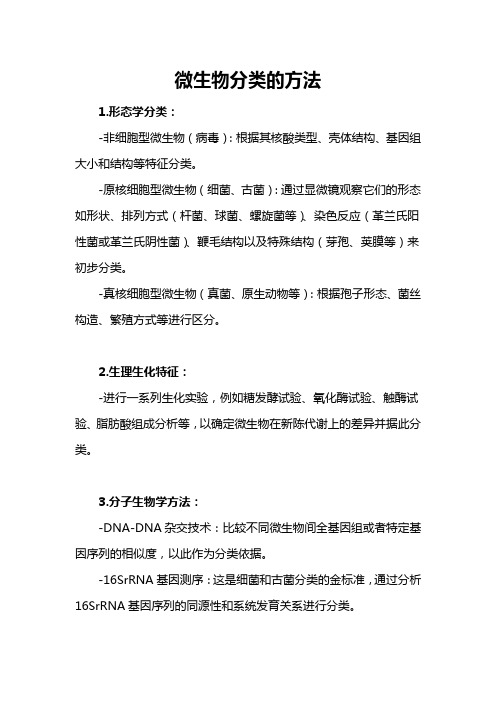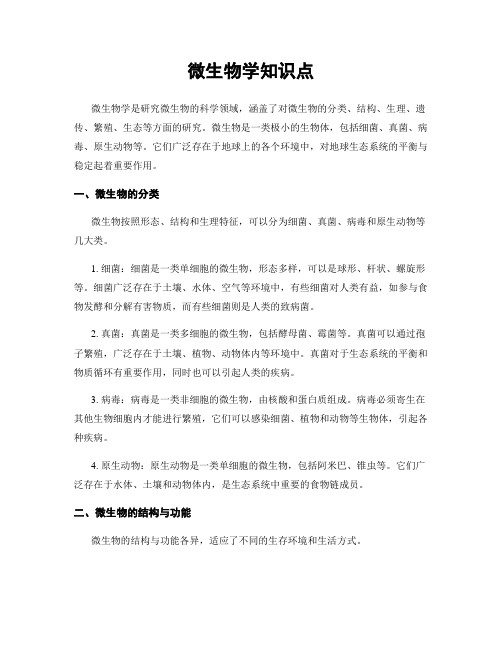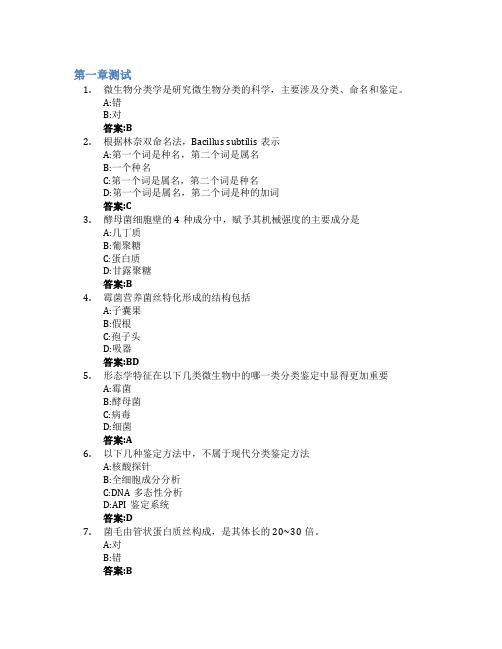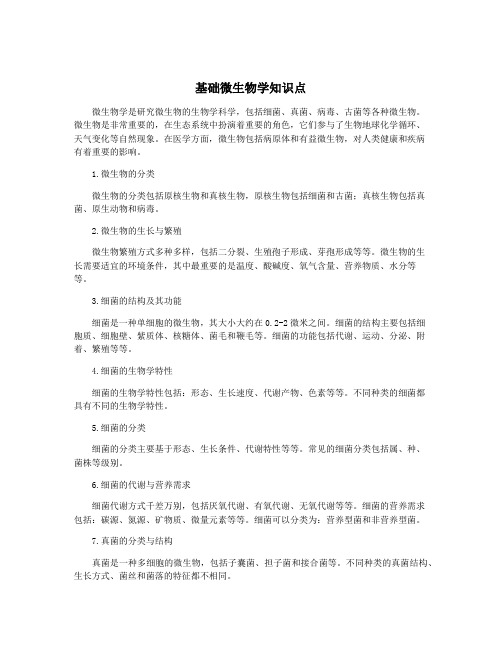1.微生物的分类学
微生物学知识点总结

绪论1、微生物的分类2、甲类法定报告传染病:鼠疫,霍乱3、发展史巴斯德:巴氏消毒法,研制鸡霍乱、炭疽和狂犬病疫苗郭霍:郭霍法则弗莱明:青霉素汤飞凡:分离出沙眼衣原体细菌的形态与结构1、观察细菌的大小和形态,应选择适宜生长条件下的对数生长期细菌为宜。
2、细菌的基本结构3、细菌细胞壁缺陷型(L-型细菌)高渗环境中可生长典型菌落:油煎蛋样菌落可恢复为原菌4、细菌的特殊结构5、细菌芽胞并不直接引起疾病,只有在芽胞发芽成为繁殖体后,才能迅速大量繁殖而致病。
6、芽胞不包含质粒。
7、细菌的抵抗力比较:有芽胞,选芽胞;无芽胞,选金黄色葡萄球菌。
8、细菌的生长繁殖(1)个体的生长繁殖二分裂;代时:15~30分钟(2)群体的生长繁殖9、细菌合成代谢产物致病作用:热原质,毒素(外毒素和内毒素),侵袭性菌鉴别作用:色素,细菌素治疗作用:抗生素,维生素噬菌体1、噬菌体是感染细菌、真菌、放线菌或螺旋体等微生物的病毒。
2、噬菌体具有病毒的基本特性:①个体微小,无细胞结构;②严格胞内寄生;③有严格的宿主特异性;④抗原性;⑤抵抗力3、噬菌体的化学组成:核酸,一种,DNA或RNA,遗传物质;蛋白质,保护核酸,识别宿主菌4、噬菌体分类①毒性噬菌体增殖过程:吸附、穿入、生物合成、成熟与释放。
吸附的原理:受体、配体特异性结合②温和噬菌体整合在细菌基因组上的噬菌体基因称为前噬菌体。
带有前噬菌体的细菌称为溶原性细菌。
三状态两周期:三状态,①游离的具有传染性的噬菌体颗粒;②宿主菌胞质内类似质粒的噬菌体核酸;③前噬菌体。
两周期:溶原性周期和溶菌性周期。
★毒性噬菌体只有溶菌性周期。
细胞的变异与遗传1、细菌基因组的组成:细菌染色体、质粒、整合在染色体中的噬菌体基因组、转座元件2、质粒的特征:①自我复制;②编码产物赋予细菌某些性状的特征;③可自行丢失与消除,非必需;④具有转移性;⑤相容性与不相容性3、细菌由野生型变为突变型,经过第二次突变恢复野生型的性状,称为回复突变;往往是表型回复突变,即第二次突变没有改变正向突变的序列,只是在其他位点发生突变,从而抑制了第一次突变的效应,称为抑制突变。
微生物分类的方法

微生物分类的方法
1.形态学分类:
-非细胞型微生物(病毒):根据其核酸类型、壳体结构、基因组大小和结构等特征分类。
-原核细胞型微生物(细菌、古菌):通过显微镜观察它们的形态如形状、排列方式(杆菌、球菌、螺旋菌等)、染色反应(革兰氏阳性菌或革兰氏阴性菌)、鞭毛结构以及特殊结构(芽孢、荚膜等)来初步分类。
-真核细胞型微生物(真菌、原生动物等):根据孢子形态、菌丝构造、繁殖方式等进行区分。
2.生理生化特征:
-进行一系列生化实验,例如糖发酵试验、氧化酶试验、触酶试验、脂肪酸组成分析等,以确定微生物在新陈代谢上的差异并据此分类。
3.分子生物学方法:
-DNA-DNA杂交技术:比较不同微生物间全基因组或者特定基因序列的相似度,以此作为分类依据。
-16SrRNA基因测序:这是细菌和古菌分类的金标准,通过分析16SrRNA基因序列的同源性和系统发育关系进行分类。
-基因组学分析:随着高通量测序技术的发展,对微生物全基因组进行测序,通过比对基因组序列构建系统发育树,实现更精细的分类。
4.生态分布与功能特性:
-微生物在自然环境中的分布、生存策略及所起的生态功能也是分类的重要参考因素。
医学微生物学各章节总结

医学微生物学各章节总结1.微生物的分类与先导说明这一章节主要介绍了微生物的分类方式,包括按形状、血清学分类、生理学分类和分子生物学分类等。
还介绍了微生物在疾病诊断和治疗中的重要性,以及微生物学研究的方法和技术。
2.微生物的培养和实验技术这一章节介绍了微生物的培养和实验技术,包括无菌技术、培养基的配制与使用、微生物培养方法和分离纯化技术等。
还介绍了微生物在实验室中的鉴定方法和常用实验技术。
3.细菌的形态和结构这一章节主要介绍了细菌的形态和结构特征,包括细菌的形态分类、细菌细胞壁、膜、质体、核酸和其他细胞结构等。
还介绍了不同形态细菌的特点和鉴定方法。
4.细菌的生长和生长控制这一章节介绍了细菌的生长方式、生长曲线和生物量增长的计算方法。
还介绍了控制细菌生长的因素,包括环境因素、营养要求和抗菌物质等。
还介绍了细菌的传代方式和筛选培养方法。
5.真菌的分类和生活方式这一章节介绍了真菌的分类方式,包括按菌丝、孢子和生殖方式分类。
还介绍了真菌的生活方式和菌丝的结构特征,包括菌丝的生长、分枝和传代。
还介绍了真菌在医学中的意义和真菌的鉴定方法。
6.真菌的致病性和防治措施这一章节主要介绍了真菌的致病机制和致病性因素,包括侵入机制和毒素产生等。
还介绍了真菌感染的常见疾病和防治措施,包括抗真菌药物的应用和防治真菌感染的方法。
7.病毒的分类和结构这一章节介绍了病毒的分类方式,包括按核酸、寄主和病原性分类。
还介绍了病毒的结构特征,包括病毒的核酸和壳蛋白等。
还介绍了病毒的复制方式和病毒寄生在细胞内的过程。
8.病毒的致病性和免疫学这一章节主要介绍了病毒的致病性因素,包括侵入机制、复制和增殖等。
还介绍了病毒感染的免疫学反应,包括感染后的细胞和体液免疫反应。
还介绍了病毒感染的诊断方法和病毒疫苗的制备和应用。
9.寄生虫的分类和生活方式这一章节介绍了寄生虫的分类方式,包括原生动物、线虫、节肢动物和扁线虫等。
还介绍了寄生虫的生活方式,包括寄生虫的寄生途径、寄生周期和病原性等。
微生物的定义和分类

微生物是一类形态微小、结构简单、肉眼看不见的微小生物,包括细菌、病毒、真菌和微藻等。
它们在自然界中广泛存在,是生物界中最重要的生物群体之一,在生态系统中扮演着重要角色。
微生物的分类可以从以下几个方面进行:
1. 细胞结构:微生物可以分为原核细胞型微生物和真核细胞型微生物。
原核细胞型微生物主要包括细菌、支原体、衣原体、立克次氏体、螺旋体和放线菌;真核细胞型微生物主要包括真菌和微藻。
2. 遗传特征:微生物可以分为需氧微生物和厌氧微生物,还可以根据代谢产物类型、酶系统等遗传特征进行分类。
3. 生理特点:微生物的生理特点包括生长速度、营养需求、抵抗力等。
根据这些特点,可以将微生物分为不同种属的细菌、放线菌、真菌等。
4. 生物分类:微生物在生物分类中属于原生生物门、真菌界、细菌界等。
微生物在自然界中分布广泛,具有重要的作用:
1. 微生物是生态系统中重要的分解者,在物质循环中扮演重要角色。
它们通过分解有机物,将有机物转化为无机物,参与生态系统中的物质循环。
2. 微生物也是生态系统中的生产者,一些自养型微生物可以通过化学合成有机物,是生态系统中的重要生产者。
3. 微生物在工农业生产中也有重要的作用,例如作为发酵剂和食品添加剂等。
4. 微生物在医疗保健领域也具有广泛的应用,例如抗生素的制造和应用等。
总之,微生物是一类重要的生物群体,具有广泛的应用价值。
随着科学技术的不断发展,人们对微生物的认识也越来越深入,对微生物的应用也更加广泛。
微生物分类章名词解释

一、名词解释1. 微生物分类学microbial taxonomy 研究微生物分类理论和技术方法的学科称为微生物分类学。
2. 分类classification 分类是根据一定的原则(表型特征相似性或系统发育相关性)对微生物进行分群归类,根据相似性或相关性水平排列成系统,并对各个分类群的特征进行描述,以便查考和对未被分类的微生物进行鉴定。
3. 命名nomenclature 命名是根据命名法规,给每一个分类群一个专有的名称。
4. 鉴定identification 指借助于现有的微生物分类系统,通过特征测定,确定未知的、新发现的或未明确分类地位微生物所应归属分类群的过程。
5. 分类单元taxon, 复数taxa 是指具体的分类群,如原核生物界(Procaryotae)、肠杆菌科(Enterobacteriaceae)、枯草芽孢杆菌(Bacillus subtilis)等都分别代表一个分类单元。
6. 种species 种是生物分类中基本的分类单元和分类等级。
微生物的种可以看作是:具有高度特征相似性的菌株群,这个菌株群与其他类群的菌株有很明显的区别。
7. 属genus 是介于种(或亚种)与科之间的分类等级,也是生物分类中的基本分类单元。
通常是把具有某些共同特征或密切相关的种归为一个高一级的分类单元,称之属。
8. 居群population 是指一定空间中同种个体的总和。
每一个物种早自然界中的存在,都有一定的空间结构,在其分散的、不连续的居住场所或分布区域内,形成不同的群体单元,这些群体单元就称居群。
9. 亚种subspecies, subsp., ssp. 当某一工人种内的不同菌株存在少数明显而稳定的变异特征或遗传性状而又不足以区分成新种时,可以将这些菌株细分成两个或更多的小的分类单元称为亚种。
亚种是正式分类单元中地位最低的分类等级。
10. 变种variety 变种是亚种的同义词。
在《国际细菌命名法规》(1976年修订本)发表以前,变种是种的亚等级,因“变种”一词易引起词义上的混淆,1976年后,细菌种的亚等级一律采用亚种,而不再使用变种。
微生物学中的微生物分类与病原性知识点

微生物学中的微生物分类与病原性知识点微生物学作为生物学的一个重要分支,研究微生物的分类和病原性对于人类的健康和生活具有重要的意义。
本文将主要探讨微生物学中的微生物分类以及一些常见微生物的病原性知识点。
一、微生物的分类在微生物学中,微生物根据其结构、形态、生活方式和代谢方式等特征进行分类。
常见的微生物主要分为细菌、真菌、病毒和寄生虫。
1. 细菌细菌是一类单细胞的微生物,其细胞结构相对简单,没有细胞核。
细菌根据其形态、染色方式和代谢方式等特征进行分类,如革兰氏染色法可以将细菌分为革兰阳性菌和革兰阴性菌。
革兰阳性菌包括金黄色葡萄球菌、链球菌等。
它们在人体内可以引起多种感染,如皮肤感染、呼吸道感染等。
革兰阴性菌包括大肠杆菌、沙门氏菌等。
这类细菌常见于食物中,摄入后会引起食物中毒等疾病。
2. 真菌真菌是一类真核细胞的微生物,其细胞结构较复杂,含有细胞核。
真菌包括酵母菌、霉菌等。
它们常见于环境中,有些真菌可以感染人体,引起真菌感染病。
例如,白色念珠菌是一种常见的真菌病原体,它可以引起阴道念珠菌病、口腔念珠菌病等疾病。
3. 病毒病毒是一种非细胞的微生物,它需要寄生于宿主细胞内进行复制。
病毒根据其核酸类型、包膜特征和宿主范围等特征进行分类。
常见的病毒有流感病毒、乙肝病毒等。
病毒感染会导致各种病症,如感冒、肝炎等。
4. 寄生虫寄生虫是一类多细胞的生物,它们需要在宿主体内寄生或寄生在寄主体表面。
寄生虫可以分为原生动物、扁形动物、线虫和节肢动物等。
常见的寄生虫有疟原虫、锥虫等。
这些寄生虫引起的疾病主要通过蚊虫叮咬、接触传播等途径。
二、微生物的病原性知识点微生物的病原性是指微生物引起疾病的能力。
不同的微生物具有不同的病原性,下面我们来介绍一些常见微生物的病原性知识点。
1. 大肠杆菌大肠杆菌是肠道常见的细菌之一,它可以引起食物中毒和尿路感染等。
其中,致病性大肠杆菌(E. coli O157:H7)是一种最为致命的大肠杆菌菌株,可以引起肠道出血性大肠杆菌感染症,严重时可导致肾衰竭和死亡。
医学微生物学复习要点重点总结

医学微生物学复习要点重点总结1.微生物的分类与特点:-根据形态特征可分为细菌、真菌、病毒、寄生虫等。
-细菌是单细胞的原核生物,可分为革兰氏阳性菌和革兰氏阴性菌。
-真菌分为真菌和酵母菌,对糖类有较好的利用能力。
-病毒是核酸包裹在蛋白质外壳中的微生物,不能自主繁殖。
-寄生虫包括原虫、线虫和吸虫等,以细胞病原为主。
2.微生物的培养与鉴定:-培养微生物可通过无菌技术和培养基进行。
-常用的培养基有富养基、选择性和差异培养基等。
-鉴定微生物可通过生理生化特性、形态特征和分子生物学方法等。
3.微生物的致病机制:-细菌通过侵袭性和毒性产生疾病,可以通过感染、产生毒素和刺激宿主免疫反应等途径。
-病毒通过侵入宿主细胞,复制自身基因组并释放新的病毒颗粒来引发感染。
-真菌通过侵袭宿主组织或产生毒力因子来导致疾病。
-寄生虫通过宿主的体液或组织进行营养摄取和生殖,同时会导致宿主免疫反应。
4.常见微生物性疾病:-呼吸道感染:如肺炎、流行性感冒等,常见病原体有肺炎链球菌和流感病毒等。
-胃肠道感染:如细菌性食物中毒、霍乱等,常见病原体有大肠杆菌和沙门氏菌等。
-皮肤感染:如疖、蜂窝组织炎等,常见病原体有葡萄球菌和链球菌等。
-泌尿生殖道感染:如尿路感染、淋病等,常见病原体有大肠杆菌和淋球菌等。
-血液感染:如败血症、疟疾等,常见病原体有金黄色葡萄球菌和疟原虫等。
5.抗微生物药物的应用:-抗生素:如青霉素、头孢菌素等,用于治疗细菌感染。
-抗真菌药物:如抗念珠菌药物、广谱抗真菌药物等,用于治疗真菌感染。
-抗病毒药物:如抗流感药物、抗艾滋病病毒药物等,用于治疗病毒感染。
-抗寄生虫药物:如抗疟疾药物、抗寄生虫原虫药物等,用于治疗寄生虫感染。
6.感染控制与预防:-感染控制重点包括手卫生、消毒、隔离和个人防护等。
-预防包括疫苗接种、健康教育和环境控制等。
在复习医学微生物学时,应重点掌握微生物的分类和特点,了解微生物的培养与鉴定方法,掌握微生物的致病机制和常见微生物性疾病,以及抗微生物药物的应用和感染控制与预防措施。
微生物学研究微生物的分类和致病机制

微生物学研究微生物的分类和致病机制微生物学作为生物学的一个重要分支,研究着微观世界中的微生物。
微生物包括细菌、真菌、病毒、原生动物等,其分类、生长特性、致病机制等是微生物学研究的重要内容。
本文将围绕微生物的分类和致病机制展开探讨。
一、微生物的分类微生物的分类主要依据其生物形态、遗传物质、生理特征等方面进行研究。
以下为主要的微生物分类:1. 细菌:细菌是一类单细胞微生物,其形态多样,主要包括球菌、杆菌、弯曲杆菌、螺旋菌等。
细菌可根据革兰氏染色特性分为革兰氏阳性菌和革兰氏阴性菌。
细菌广泛存在于自然界中,既有益处,也有害处。
有些细菌能够促进土壤的肥沃和植物的生长,而一些致病菌可引起人和动物的疾病。
2. 真菌:真菌是一类多细胞或单细胞的微生物,其细胞包含真核细胞核。
真菌在分类上可分为酵母菌、霉菌和子囊菌等。
真菌具有不同的形态,如孢子、菌丝等。
真菌广泛存在于土壤、空气和水中,对环境和生态系统有着重要作用。
一些真菌可作为食物,如酵母菌可用于发酵制作面包,而一些真菌也可以引起人类的真菌感染病。
3. 病毒:病毒是一类非细胞的微生物,只能在寄生细胞内进行繁殖。
病毒通常由遗传物质(RNA或DNA)和蛋壳组成,其大小较小,只能通过电子显微镜观察到。
病毒广泛存在于生物体内,可以感染人类、动物和植物等生物体,引起各种传染病。
4. 原生动物:原生动物是一类以单细胞生物为代表的微生物。
原生动物的分类较复杂,根据其细胞形态和运动方式可分为鞭毛虫、纤毛虫和阿米巴虫等。
原生动物广泛分布于水体和土壤中,对生态系统中的物质循环和生物体的分解起着重要作用。
一些原生动物也可引起人类的疾病,如阿米巴原虫引起的阿米巴性痢疾。
二、微生物的致病机制微生物的致病机制是指微生物引起疾病的具体过程和机理。
不同的微生物通过不同的途径和机制引发疾病,以下为常见的致病机制:1. 感染与寄生:微生物通过侵入宿主细胞并破坏宿主免疫系统,引起感染和寄生。
例如,细菌可以通过释放毒素杀死宿主细胞,病毒则将其遗传物质注入宿主细胞并利用细胞机制进行复制。
微生物的分类

分子分类法
• 在分子水平上对生物个体的信息大分子 DNA、RNA和蛋白质进行研究, 将获得 的遗传信息用于对生物个体的分类鉴定。
• 原核生物中, 目前常用的分子分类法包括 G+C mol%、DNA-DNA杂交、16srRNA序 列分析及DNA指纹图谱等。
( 四 ) 核酸的碱基组成和分子杂交
与形态及生理生化特性的比较不同,对DNA的 碱基组成的比较和进行核酸分子杂交是直接比较不 同微生物之间基因组的差异,因此结果更加可信。
2. 核酸分子杂交: a)DNA-DNA杂交; b)DNA-rRNA杂交; c)rRNA-rRNA杂交;
直接分析比较DNA的碱基排列顺序
------由于技术上的困难目前尚难以普遍地进行; 核酸分子杂交(hybridization)间接比较不同微生物DNA
碱基排列顺序的相似性
3. 16S rDNA
• 最有代表性和最有影响的细菌分类系统 《伯杰氏细菌鉴定手册》
(Bergey’s Manual of Determinative Bacteriology) 1923年, 1925年, 1930年, 1934年, 1939年, 1948年, 1957年, 1974年分别出版了第一至第 八版,1994年出了第九版 以形态、生理生化、G + C mol%、生态分布等 特征为主
• 中国工业微生物菌种保藏管理中心, China Center of Industrial Culture Collection (CICC) 网址:/
• 中国普通微生物保藏管理中心, China General Microbiological Culture Collection Cente (CGMCC) 网址:/
菌种保藏机构
微生物的分类方法

微生物的分类方法微生物是指肉眼无法看到的微小生物,主要包括原核生物和真核生物两大类。
原核生物主要包括细菌和蓝藻,真核生物则包括真菌、原生动物和微藻等。
对于微生物的分类,科学家们采用了多种方法,其中最常用的是基于形态学、生理学、生态学和分子生物学的分类方法。
下面将介绍这些分类方法的主要内容。
1.形态学分类:这是最早也是最基础的分类方法,主要根据微生物的形态特征进行分类。
例如,根据细菌的形状,可以将其分为球形细菌(如链球菌)、杆状细菌(如大肠杆菌)和螺旋细菌(如梅毒螺旋体)等。
此外,还可以根据真核微生物的细胞结构和生殖特征进行分类。
3.生态学分类:这种分类方法是根据微生物在自然界中的生活习性和分布情况进行分类。
例如,根据微生物生活的环境,可以将其分为土壤微生物(如放线菌)、水体微生物(如蓝藻)和肠道微生物(如乳酸菌)等。
此外,还可以根据微生物在生态系统中的作用,将其分为分解者、产生者和共生微生物等。
4.分子生物学分类:这种分类方法是根据微生物的基因组序列和分子结构进行分类。
利用分子生物学技术,可以通过测定微生物的DNA序列,比较不同微生物之间的遗传关系和相似性,从而将其分类到不同的系统发生树分支上。
此外,还可以利用分子标记的方法,如PCR和基因测序,快速鉴定微生物的种类。
除了以上分类方法外,还有一些更细致和专业的分类方法,比如对特定微生物群体进行研究的分类方法。
例如,对细菌进行分类可以使用质谱分析技术,对真菌进行分类可以使用菌株的生长特性和生殖结构等特征。
总的来说,微生物的分类方法是一个不断发展和完善的过程。
随着技术的进步和对微生物世界的深入了解,我们对微生物的分类将更加准确和精细,为微生物相关领域的研究和应用提供更好的支持。
微生物学知识点

微生物学知识点微生物学是研究微生物的科学领域,涵盖了对微生物的分类、结构、生理、遗传、繁殖、生态等方面的研究。
微生物是一类极小的生物体,包括细菌、真菌、病毒、原生动物等。
它们广泛存在于地球上的各个环境中,对地球生态系统的平衡与稳定起着重要作用。
一、微生物的分类微生物按照形态、结构和生理特征,可以分为细菌、真菌、病毒和原生动物等几大类。
1. 细菌:细菌是一类单细胞的微生物,形态多样,可以是球形、杆状、螺旋形等。
细菌广泛存在于土壤、水体、空气等环境中,有些细菌对人类有益,如参与食物发酵和分解有害物质,而有些细菌则是人类的致病菌。
2. 真菌:真菌是一类多细胞的微生物,包括酵母菌、霉菌等。
真菌可以通过孢子繁殖,广泛存在于土壤、植物、动物体内等环境中。
真菌对于生态系统的平衡和物质循环有重要作用,同时也可以引起人类的疾病。
3. 病毒:病毒是一类非细胞的微生物,由核酸和蛋白质组成。
病毒必须寄生在其他生物细胞内才能进行繁殖,它们可以感染细菌、植物和动物等生物体,引起各种疾病。
4. 原生动物:原生动物是一类单细胞的微生物,包括阿米巴、锥虫等。
它们广泛存在于水体、土壤和动物体内,是生态系统中重要的食物链成员。
二、微生物的结构与功能微生物的结构与功能各异,适应了不同的生存环境和生活方式。
1. 细菌结构与功能:细菌通常由细胞壁、细胞膜、细胞质、核糖体等组成。
细菌可以进行光合作用、呼吸作用和发酵作用等代谢过程。
有些细菌还能产生酶、激素等物质,对环境有调节作用。
2. 真菌结构与功能:真菌通常由菌丝、菌核和孢子等组成。
真菌通过菌丝在有机物上进行分解和吸收,起到分解有机物和循环养分的作用。
同时,真菌还能产生抗生素、酶和食物等。
3. 病毒结构与功能:病毒主要由核酸和蛋白质组成,没有细胞结构。
病毒通过感染细胞进行繁殖,对宿主细胞产生破坏作用,引起各种疾病。
4. 原生动物结构与功能:原生动物通常由细胞膜、细胞质和细胞核等组成。
它们通过摄食和吸收等方式获取营养,同时也是其他生物的食物来源。
微生物的分类学和鉴定技术

微生物的分类学和鉴定技术微生物是指体形微小而能自主繁殖的生物体,包括细菌、真菌、病毒等多种类型。
微生物是生命的基础单元之一,广泛存在于自然界和人类体内,既有益于人类,也可能对人类健康构成威胁。
因此,了解微生物的分类学和鉴定技术对于生命科学和医疗保健等领域具有重要意义。
一、微生物分类学微生物分类学是指对微生物进行分类和鉴定的学科,其目的是建立一套科学的分类体系,以方便研究、鉴定和应用。
微生物分类学的基础是形态学、生理学和生化学等,通过对微生物形态、生长特性、代谢产物等进行研究,进而归纳出微生物的分类系统。
目前,主要的微生物分类方法包括形态学、生理学、生化学、分子生物学等。
1. 形态学分类法形态学分类法是最早的微生物分类法之一,通过对微生物的形态特征进行分类和鉴定。
该方法主要适用于细菌和真菌等多细胞体生物,通过观察细胞形态、胞壁、胞膜、菌落等特征,将其划分为不同的种类。
例如,细菌可以根据形态、大小、染色性质、运动方式等特征进行分类,如革兰氏染色可以将细菌分为革兰氏阳性菌和革兰氏阴性菌,形态特征可以将细菌分为球菌、杆菌、弧菌、螺旋杆菌等。
2. 生理学分类法生理学分类法是根据微生物的代谢特性进行分类和鉴定。
通过研究微生物的营养需求、代谢能力、乳酸发酵等特征,将其划分为不同的种类。
该方法适用于细菌和真菌等多细胞体生物。
例如,乳酸杆菌可以通过研究其乳酸代谢能力进行分类,如以乳酸杆菌为主发酵的食品,可根据不同的发酵条件来控制菌群的比例,进而产生不同种类的发酵食品。
3. 生化学分类法生化学分类法是根据微生物代谢产物和生化反应特征进行分类和鉴定,通过研究微生物代谢物质的产生和分解途径等,将其划分为不同的种类。
该方法适用于细菌和真菌等多细胞体生物。
例如,黄色链霉菌通过对黄色素的合成和代谢进行研究,可以发现其对糖类、氨基酸和核苷类物质的利用能力较为广泛,从而对其进行分类鉴定。
4. 分子生物学分类法分子生物学分类法是将微生物的分类鉴定从形态、生理、生化等方面转向生物分子水平的一种分类鉴定方法。
微生物分类鉴定的方法

微生物分类鉴定的方法1.形态学分类:这是最基本也是最传统的微生物分类方法。
通过观察微生物的形态特征,如细胞形状、大小、颜色、胞壁结构等,来进行分类鉴定。
典型的形态学分类方法包括显微镜观察、染色法、显微观察等。
2.生理学分类:通过对微生物的生理特征进行观察和测定,来进行分类鉴定。
生理学分类侧重于微生物的生长环境、生长要求、生长曲线等特征,能够揭示微生物与环境的相互关系。
常见的生理学分类方法包括生物化学试验、生长条件试验等。
3.生化学分类:通过观察和测定微生物的生化特征,如碳源利用能力、氮源利用能力、氧需求量等,来进行分类鉴定。
这种分类方法可通过对微生物的代谢产物分析,从而更直接地鉴定微生物的分类位置。
4.分子生物学分类:这是一种相对新兴的分类方法,通过对微生物的遗传物质进行分析,来进行分类鉴定。
分子生物学技术如DNA序列分析、PCR等,能够更精确地鉴定微生物的分类位置,并且具有高度的重复性和可靠性。
除了以上几种常用的分类方法,还有一些特殊的分类鉴定方法,如:5.免疫学分类:通过对微生物的免疫特征进行观察和测定,来进行分类鉴定。
常用的免疫学分类方法包括酶联免疫吸附试验(ELISA)、流式细胞术等。
6.基因组学分类:利用整个基因组序列和基因组结构等信息对微生物进行分类鉴定。
这种分类方法可以揭示微生物间的亲缘关系,为微生物分类提供了更深入的信息。
需要注意的是,用于微生物分类鉴定的方法往往需要多种方法的综合应用。
使用不同的分类方法,可以得到更全面和准确的鉴定结果。
此外,随着技术的不断发展和创新,还会出现更多精确和快速的微生物分类鉴定方法。
微生物的分类

微生物的分类一、微生物的概述微生物是指体积极小的生物体,无法肉眼直接观察,但它们在生物圈中的分布和数量却有着无可比拟的重要性。
微生物包括细菌、真菌、病毒、原生动物等各种类型,它们在生态系统中承担着许多重要作用,如维持生态平衡、分解有机物质、生产氧气等。
此外,人类通过利用微生物的功能来生产食品、药品等产品,在生产中有着重要作用。
二、微生物的分类微生物是如此之多,以至于对它们的分类和命名已成为一个庞大的学科。
下面我们介绍几种常见的微生物分类方法。
1. 形态学分类法形态学分类法是最早出现的微生物分类方法,它是根据微生物形态和结构的差异来进行分类的。
根据形态学分类法,微生物可分为真菌、细菌和原生动物三大类。
(1) 真菌真菌是一类含有多种单细胞生物和多细胞生物的生物界,在极小微生物中具有重要作用。
真菌的细胞呈现分支状,它们的菌体包括菌丝、支原体、酵母和霉菌等。
真菌分为两类:单细胞真菌和多细胞真菌。
单细胞真菌单个细胞大小相同,通常以酵母形态存在,如啤酒酵母、面包酵母等。
多细胞真菌的菌丝是由一个细胞长成的,通常以线状或扇形的菌丝体细胞群体存在,如星球菌、发霉菌等。
(2) 细菌细菌是最简单的生物体系,是一类无色、透明、颗粒较小的微生物,它们的形态和大小各不相同。
细菌分为光合细菌和非光合细菌。
光合细菌依靠光合作用来获得能量,而非光合细菌依赖于化学反应來获得能量和营养。
细菌是生态系统中的重要组成部分,它们可以分解有机物质和为植物提供养分等。
(3) 原生动物原生动物是一类单细胞的生物体,它们有着丰富的形态和结构,能够以假足等特殊器官运动和获取食物。
原生动物分为单细胞和多细胞两类。
单细胞原生动物包括阿米巴和纤毛虫等,而多细胞原生动物则包括异矛虫等。
2. 生化分类法生化分类法是根据微生物的生理代谢方式和对外部环境的适应能力等因素来进行分类的。
根据生化分类法,微生物可分为好氧微生物、厌氧微生物、光合微生物和化石微生物等不同类型。
食品微生物学智慧树知到答案章节测试2023年西北大学

第一章测试1.微生物分类学是研究微生物分类的科学,主要涉及分类、命名和鉴定。
A:错B:对答案:B2.根据林奈双命名法,Bacillus subtilis表示A:第一个词是种名,第二个词是属名B:一个种名C:第一个词是属名,第二个词是种名D:第一个词是属名,第二个词是种的加词答案:C3.酵母菌细胞壁的4种成分中,赋予其机械强度的主要成分是A:几丁质B:葡聚糖C:蛋白质D:甘露聚糖答案:B4.霉菌营养菌丝特化形成的结构包括A:子囊果B:假根C:孢子头D:吸器答案:BD5.形态学特征在以下几类微生物中的哪一类分类鉴定中显得更加重要A:霉菌B:酵母菌C:病毒D:细菌答案:A6.以下几种鉴定方法中,不属于现代分类鉴定方法A:核酸探针B:全细胞成分分析C:DNA多态性分析D:API鉴定系统答案:D7.菌毛由管状蛋白质丝构成,是其体长的20~30倍。
A:对B:错答案:B8.特殊结构指的是某些细菌在生长的特定阶段所形成的结构,例如()。
A:糖被B:鞭毛C:内含物D:芽孢答案:ABD9.包膜是病毒的必须结构。
A:对B:错答案:B10.只含有蛋白质不含有核酸的病毒是()。
A:阮病毒B:真病毒C:拟病毒D:类病毒答案:A第二章测试1.肉毒杆菌是典型的厌氧微生物。
A:错B:对答案:B2.培养酵母菌的常用温度是?A:36℃B:32℃C:28℃D:22℃答案:C3.微生物营养类型有哪几种?A:光能异养型B:化能自养型C:光能自养型D:化能异养型答案:ABCD4.细胞的促进扩散运输需要消耗能量。
A:错B:对答案:A5.主动运输需要依赖细胞膜上的嵌入蛋白,如Na+泵。
A:对B:错答案:A6.配制固体培养基加琼脂量是?A:3%B:1%C:4%D:2%答案:D7.常用的细菌培养基有肉汤培养基和琼脂培养基。
A:对B:错答案:A8.酵母菌通常使用以下哪种培养基培养?A:麦芽糖琼脂培养基B:牛肉膏蛋白胨培养基C:查氏合成培养基D:高氏一号合成培养基答案:B9.培养基按成分分为以下哪几种?A:半合成培养基B:天然培养基C:合成培养基D:基础培养基答案:ABC第三章测试1.以下哪种方法属化疗:()A:75%乙醇B:磺胺药C:苯甲酸D:碘酒答案:B2.在发酵工业中,调节发酵液pH的措施正确的是:()A:过酸时,降低通气量B:过酸时,适当降低氮源C:过碱时,增加通气量D:过碱时,加适当碳源答案:D3.以下属于耐酸微生物的是:()A:乳酸杆菌B:链霉菌C:硫杆菌属D:硝化细菌答案:A4.从对分子氧的要求来分,微生物可分为哪几种类型。
微生物的分类和鉴定方法

微生物的分类和鉴定方法微生物是一类微小的生物体,包括细菌、真菌、病毒等。
它们广泛存在于地球上的各个角落,对环境、人类健康以及生物系统的平衡具有重要影响。
准确的微生物分类和鉴定方法对于研究微生物、开展微生物相关工作具有重要意义。
本文将从微生物的分类和鉴定方法两个方面进行探讨。
一、微生物的分类微生物的分类是根据它们在形态、结构、生理特征、遗传信息等方面的差异而进行的。
目前,微生物主要被分为以下几类:1. 细菌:细菌是一类单细胞、无细胞核的微生物,形态多样,包括球菌、杆菌、螺旋菌等。
根据细菌的生理特性、代谢途径和环境需求等,可以将其细分为革兰氏阳性菌和革兰氏阴性菌。
2. 真菌:真菌是一类多细胞或单细胞的真核生物。
它们通过孢子繁殖,主要包括酵母菌、霉菌等。
真菌可以根据生殖方式和菌丝结构的特点进行分类。
3. 病毒:病毒是一种非细胞的微生物,只能通过感染宿主生物来进行繁殖。
病毒可以根据核酸类型、外壳结构和感染宿主范围等进行分类。
二、微生物的鉴定方法微生物的鉴定方法是指通过一系列实验和技术手段来确定微生物的分类和鉴别微生物的种类。
常用的微生物鉴定方法有:1. 形态学鉴定:通过观察微生物的形态特征,如大小、形状、颜色等,来确定其分类。
例如,细菌的形态鉴定可以通过显微镜观察细菌的形态结构,真菌的鉴定可以通过观察菌落和菌丝结构。
2. 生理生化特性鉴定:通过测定微生物的生理生化特性,如生长适宜温度、代谢产物等,来判断其分类。
例如,酸碱度试验可用于区分细菌的鉴定。
3. 分子生物学鉴定:利用分子生物学技术,如PCR、DNA测序等,对微生物的核酸序列进行分析,从而确定微生物的分类和鉴定。
这种方法通常具有高度准确性和可靠性。
4. 免疫学鉴定:通过检测微生物与抗体的相互作用,例如免疫沉淀试验、免疫荧光染色等,来鉴定微生物的种类。
综上所述,微生物的分类和鉴定方法是通过对微生物的形态、结构、生理特征、遗传信息等方面进行观察和实验,来确定其分类和鉴定。
基础微生物学知识点

基础微生物学知识点微生物学是研究微生物的生物学科学,包括细菌、真菌、病毒、古菌等各种微生物。
微生物是非常重要的,在生态系统中扮演着重要的角色,它们参与了生物地球化学循环、天气变化等自然现象。
在医学方面,微生物包括病原体和有益微生物,对人类健康和疾病有着重要的影响。
1.微生物的分类微生物的分类包括原核生物和真核生物,原核生物包括细菌和古菌;真核生物包括真菌、原生动物和病毒。
2.微生物的生长与繁殖微生物繁殖方式多种多样,包括二分裂、生殖孢子形成、芽孢形成等等。
微生物的生长需要适宜的环境条件,其中最重要的是温度、酸碱度、氧气含量、营养物质、水分等等。
3.细菌的结构及其功能细菌是一种单细胞的微生物,其大小大约在0.2-2微米之间。
细菌的结构主要包括细胞质、细胞壁、紫质体、核糖体、菌毛和鞭毛等。
细菌的功能包括代谢、运动、分泌、附着、繁殖等等。
4.细菌的生物学特性细菌的生物学特性包括:形态、生长速度、代谢产物、色素等等。
不同种类的细菌都具有不同的生物学特性。
5.细菌的分类细菌的分类主要基于形态、生长条件、代谢特性等等。
常见的细菌分类包括属、种、菌株等级别。
6.细菌的代谢与营养需求细菌代谢方式千差万别,包括厌氧代谢、有氧代谢、无氧代谢等等。
细菌的营养需求包括:碳源、氮源、矿物质、微量元素等等。
细菌可以分类为:营养型菌和非营养型菌。
7.真菌的分类与结构真菌是一种多细胞的微生物,包括子囊菌、担子菌和接合菌等。
不同种类的真菌结构、生长方式、菌丝和菌落的特征都不相同。
8.真菌的功能与特性真菌有多种功能,包括分解生物体、生产有用化合物等等。
真菌的特性包括菌丝生长、有环化合物的形成、生物降解等等。
9.病原体的分类病原体包括病毒、细菌、真菌和寄生虫等。
不同类型的病原体对机体的伤害也不相同。
10.病原体感染的过程病原体引起感染的过程包括:接触、侵入、增殖和病理效应等。
不同的病原体在感染过程中的特点也不相同。
11.免疫系统和免疫反应免疫系统是机体行动的一种方式,包括先天性免疫和获得性免疫两个方面。
tem名词解释微生物学

tem名词解释微生物学
微生物学是研究微生物的结构、生理、生态、分类、遗传、病原性和应用等方面的科学学科。
微生物学涵盖了细菌、真菌、病毒、原生动物和古菌等微小生物的研究。
以下是微生物学的一些关键概念:
1.微生物:微生物是指肉眼无法直接观察到的微小生物。
这
包括单细胞和多细胞生物,如细菌、酵母菌、霉菌、病毒等。
微生物存在于各种环境中,如土壤、水体、大气、人体等。
2.微生物的结构和形态:微生物的结构多样,可以是单细胞
或多细胞,具有不同的形态和大小。
例如,细菌是单细胞的原核生物,具有各种形状,如球形、杆状、螺旋形等。
3.微生物生理:微生物的生理过程包括代谢、营养摄取、生
长和繁殖等。
微生物通过吸收营养物质,利用能量进行代谢活动,并分裂或繁殖形成新的细胞。
4.微生物的生态功能:微生物在各种生态系统中起着重要的
作用,如土壤中的微生物参与有机物分解和养分循环,水体中的微生物控制水质和生物降解等。
5.微生物的分类学:微生物根据其形态、生理特征、基因序
列等进行分类。
分类学系统有助于理解微生物的多样性、演化和功能。
6.微生物的应用:微生物学在多个领域具有广泛的应用,包
括农业、食品工业、医药、环境保护、基因工程等。
微生物可以用于发酵生产食品和药物,也可以用于控制病原微生物和污染物的生物处理。
微生物学的发展对于人类的健康、环境保护和可持续发展具有重要意义。
通过对微生物的研究,我们可以了解微生物世界的奥秘,利用微生物的功能和特性解决各种实际问题。
微生物的分类和特征

微生物的分类和特征微生物是一类存在于生态系统中的微小单细胞生物体,它们广泛存在于地球的各个角落,包括土壤、水体、空气、人体等。
微生物的分类和特征对于了解它们的生态功能以及对环境和人类的影响至关重要。
本文将介绍微生物的分类和特征,以便更好地理解微生物的多样性和重要性。
一、微生物的分类根据生物分类学的原则,微生物可以分为原核生物和真核生物两大类。
1. 原核生物原核生物是指没有真核细胞核的微生物。
原核生物包括细菌(Bacteria)和古菌(Archaea)两个域。
细菌是最常见且广泛存在的原核生物。
它们具有简单的细胞结构,没有真核细胞核,基因位于细胞质中,细胞壁的主要成分是肽聚糖和脂质。
细菌根据形状的不同,可分为球菌、杆菌和螺旋菌等。
古菌是一类与细菌有所不同的原核生物。
它们通常生存在极端环境中,如高温泉、盐湖和深海等。
古菌的细胞结构与细菌相似,但具有一些特殊的生理和生化特征,使其能够适应极端条件。
2. 真核生物真核生物是指具有真核细胞核的微生物。
真核生物包括真菌(Fungi)、原生生物(Protista)和原生动物(Protozoa)三个类群。
真菌是一类寄生或腐生的微生物,其细胞结构与植物相似,但没有叶绿素。
真菌可以分为菌丝菌和酵母菌两种形态。
它们在环境中的分解作用对于有机物质循环和生态平衡具有重要意义。
原生生物是一类原核生物和真核生物的过渡形式。
它们结构简单,功能多样。
原生生物包括各种单细胞藻类、滑液虫和纤毛虫等。
原生动物是一类单细胞或多细胞的异养真核生物。
它们以异养方式获取营养,并在生态系统中扮演捕食者和分解者的角色。
原生动物通常通过纤毛、鞭毛或伪足等结构进行运动和摄取。
二、微生物的特征微生物作为生态系统中的重要组成部分,具有以下几个特征:1. 极强的适应能力微生物在各种环境条件下都能够生存和繁殖,包括极端的高温、低温、酸碱度和高压等环境。
它们能够通过调节代谢途径和细胞结构来适应不同的环境条件。
2. 高度多样性微生物具有极高的多样性,不同种类微生物的基因组和代谢途径都存在差异。
...3.菌种鉴定的方法。了解1.微生物的分类系统。2.菌

属名在上下文重复出现的情况下,可以缩写。例如
Bacillus可用Bac.表示。
(4)学名的第二个词为种名。
种名是拉丁语中的形容词,表示微生物的次要特征。
3.子囊菌亚门(Ascomycotina)
营养体是有隔膜的菌丝体,极少数是单细胞。有性 繁殖形成子囊和子囊孢子。根据是否形成子囊果和子囊 果的类型以及子囊的结构,分为6个纲:半子囊菌纲、 不整子囊菌纲、核菌纲、盘菌纲、虫囊菌纲和腔菌纲。
4.担子菌亚门(Basidiomycotina)
营养体是有隔膜的菌丝体。有性繁殖形成 担孢子。根据担子果的有无以及开裂与否,分 为3个纲:冬孢菌纲、层菌纲和腹菌纲。
1、微生物的分类单位:
和高等动植物分类一样,微生物的分类单位也依 次分为界(Kingdom)、门(Phylum)、纲 (Class)、目(order)、科(Family)、属 (Genus)、种(Species)。这是分类中所用的主要分 类等级单位。
有时在两个主要分类单位之间,可添上次级分类单 位,如“亚门”、“亚纲”、“亚 目”、“亚科”、 “亚属”等。在科与属之间有时还可有“族”(Tribe) 一级。
类群(group series)
通常指属以下几个比较近似的种的集合。具体做法 是选一些特征最为明显的典型菌株,再把和它近似的菌 株放在一起归为一个类群。
例如,抗生素的主要产生菌——链霉菌属,为了筛 选新种的方便,把该属中的近似的种,归纳为14个类群。 又如,曲霉属内,根据属内近似的种,归纳为18个类群。
- 1、下载文档前请自行甄别文档内容的完整性,平台不提供额外的编辑、内容补充、找答案等附加服务。
- 2、"仅部分预览"的文档,不可在线预览部分如存在完整性等问题,可反馈申请退款(可完整预览的文档不适用该条件!)。
- 3、如文档侵犯您的权益,请联系客服反馈,我们会尽快为您处理(人工客服工作时间:9:00-18:30)。
Defintion of “species” in microbiology:
• Classic definition: A collection of microbial strains that share many properties and differ significantly from other groups of strains •There are several collections of type strains, including the American Type Culture Collection (ATCC)
Classification Systems
• Classification systems continue to evolve and will change as new information is discovered
– emerging technology increases the knowledge base of organisms
– virus particle structure
• isometric, helical, pleomorphic???
– presence or absence of viral envelope
4. Nomenclature
• Organisms must have a Latin suffix • Name is italicized or underlined • All organisms have a binomial name – 1st part of the binomial name is genus • 1st letter capitalized – 2nd part or the binomial name is the species epithet
– Linnaeus placed all microorganism in one genus he named Chaos
Classification Systems: a short history
• in 1866, Ernst Haeckel 海克尔) (海克尔)divided animals, plants, and microorganisms into 3 kingdoms
Microbial Taxonomy
Zhijiang Zhou 2009.10.05
Outline
• • • • • Taxonomy Levels of Classification Classification Systems: a short history Nomenclature Useful Properties in Microbial Classification • Microbial Phylogeny
rRNA作为进化的指征 rRNA作为进化的指征
16S rRNA相对分子质量大小适中,便于序列分 相对分子质量大小适中, 相对分子质量大小适中 析; – 16S rRNA: ancient conserved sequences of about 1500kb 16S rRNA普遍存在于真核生物和原核生物中 普遍存在于真核生物和原核生物中 真核生物中其同源分子是18SrRNA)。 )。 (真核生物中其同源分子是
– identification
• characterizing organisms
– classification
• arranging into similar groups
– nomenclature
• naming organisms
Taxonomy
organizing larger organisms d on morphology is often quite simple:
3. Classification Systems: a short history
• in 1750, Carl Linnaeus devised the first classification system, placing plants and animals in separate systems
Nomenclature
• Species name – include both genus and species epithet(种号) (种号) • Lactococcus lactis – Genus name is capitalized and may be abbreviated • L. lactis – Species name is never abbreviated – A genus name may be used alone to indicate a genus group; a species name is never used alone – eg: Bacillus subtilis B. subtilis
verses
feathers
verses
fur
fins legs with microorganisms, it is not as simple
Classification technologies
• used to characterize and ID Microorganisms
– microscopic examination – culture characteristics – biochemical testing – nucleic acid analysis – combination of the above is most accurate
Defintion of “species” in microbiology:
• type
– Biovars: Strains that differ in biochemical or physiological differences – Morphovars: Strains that vary in morphology – Serovars: Stains that vary in their antigenic properties
Defintion of “species” in microbiology:
• Strain:
– A population of microbes descended from a single individual or pure culture – Different strains represent genetic variability within a species
– – – – – Animalia Plantae Fungi Protista(原生生物): include algae and protozoa (原生生物): Monera(原核生物) (原核生物)
Classification Systems: a short history
• in 1970, Carl Woese, by analyzing RNA, developed the 3 domain classification system
Classification of Viruses
• Viruses are not included in the 3 Domain classification system • Viruses are not composed of cells
– the ecological niche of a virus is the host cell – viruses may be more related to their host than to other viruses
16S rRNA as a biomarker gene
• Carl Woese: 1928• Comparison of the DNA sequences of a specific gene can offer evolutionary and taxonomical insights in the microbial world. • Ideal molecule: Universally distributed. Functionally homologous. Evolving at a suitable rate. Suitable size: 500-2000 bp. No lateral gene transfer.
– Animalia – Plantae – Protista(原生生物) (原生生物)
Haeckel’s Tree of Life
Classification Systems: a short history
• in 1969, Robert Whittaker(魏塔科) created (魏塔科) a 5 Kingdom classification system, using obvious morphological differences
Classification of Viruses
• Though not included in the 3 domain system, classification of virus is currently based on
– genome structure
• single, double, DNA, RNA???
– archaebacteria – bacteria – eucarya
• This system is currently favored by microbiologists.
rRNA作为进化的指征 rRNA作为进化的指征
• rRNA参与生物蛋白质的合成过程,其功能是任何 参与生物蛋白质的合成过程, 参与生物蛋白质的合成过程 生物都必不可少的, 生物都必不可少的,而且在生物进化的漫长历程 其功能保持不变; 中,其功能保持不变; • 在16S rRNA分子中,即含有高度保守的序列区 分子中, 分子中 又有中度保守和高度变化的序列区域, 域,又有中度保守和高度变化的序列区域,因而 它适用于进化距离不同的各类生物亲缘关系的研 究;
